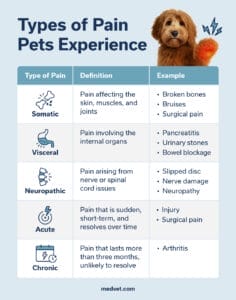
How to Tell If Your Pet Is in Pain and What You Can Do to Help
Animals feel pain just like humans, and they can’t let us know when or where they hurt. Learn what to look for and how you can help.
Animals feel pain for many of the same reasons humans do, including dental issues, arthritis, infections, broken bones, cancer, post-surgical pain, strains and sprains, back problems, stomach upset, constipation, urinary tract infections, and other injuries or illnesses.
Unfortunately, unlike humans, they can’t tell us when or where it hurts. Instead, they often show subtle behavioral and physical changes. As a pet parent, you are in the best position to notice these signs.
Here are some clinical signs that your pet may be experiencing pain.
Signs Your Dog May Be in Pain
Dogs express pain in different ways, some obvious (like whining), and others more subtle. Factors like age and breed also influence how dogs show discomfort. For instance, older dogs or puppies may be less expressive, while some breeds are naturally more stoic or sensitive. Some signs your dog may be in pain include:
- Change in Activity Level: restlessness, reluctance to move, difficulty getting up, repetitively gets up and lies down, trembling, lying very still, seeks more affection than usual, hides, shows reluctance to jump or use stairs
- Unusual Behavior: aggression, changes in daily habits, vocalizing (whining, whimpering, yelping), changes in sleeping or eating/drinking habits, accidents in the house, excessive panting while at rest
- Altered Body Positions or Movements: grimacing, vacant stare, hunched posture, or protecting a body part
- Change in Self-Care: poor grooming or self-mutilation (licking, biting, or scratching a particular area)
- Self-Protection: protects a body part, doesn’t put weight on a limb or has a limp, doesn’t want to be held or picked up
Our blog post on dog behaviors provides more details about common actions, their meanings, and when to consult a veterinarian.
Signs Your Cat May Be in Pain
Cats are more likely than dogs to hide pain, making it harder to recognize. Be aware of changes in their normal behavior rather than specific pain-related actions. Signs your cat may be in pain include:
- Change in Activity Level: Reluctance to move, difficulty getting up, trembling, limping, reduced jumping ability, hiding, or seeking more affection. Some may avoid being handled.
- Unusual Behavior: unusual meowing, growling, hissing, biting, pinning ears back, withdrawal, altered sleeping or eating patterns, accidents outside the litter box, or frequent urination
- Altered Body Positions or Movements: grimacing, furrowed brow, wide eyes, dilated pupils, flattened ears, sitting with feet tucked under, arching the back, tucking in the abdomen, or panting at rest
- Change in Self-Care: decreased grooming or self-mutilation (licking, biting, or scratching a specific area)
- Self-Protection: guarding a body part, avoiding weight on a limb, limping, or resisting touch

For more information on pain management in cats and common cat behaviors and their meanings, read our blog posts.
Do Animals Show Pain the Same Way?
Every animal is unique in how it experiences and expresses pain. Two pets with the same condition may react very differently. Pain can also be multifactorial, meaning one animal may suffer from more than one type of pain at a time.
Types of Pain Pets Experience
Pain is typically classified by where it’s felt in the body. Pets can experience one or more of these types at once:
- Somatic Pain: Affects skin, muscles, and joints. Examples include broken bones, bruises, or surgical pain.
- Visceral Pain: Involves internal organs. Causes include pancreatitis, urinary stones, or intestinal blockages.
- Neuropathic Pain: Arises from nerve or spinal cord issues, such as a slipped disc, nerve damage, certain cancers, phantom limb pain, or peripheral neuropathy.
Pain is also categorized by duration:
- Acute Pain: Sudden onset pain, typically from injury or surgery. It’s often easier to identify, is shorter lasting, and resolves with time and treatment.
- Chronic Pain: Lasts more than three months (e.g., arthritis). Chronic pain is harder to diagnose and will never completely go away, but it can be managed to keep your pet comfortable and living their best life.

How You Can Help a Pet in Pain
If you suspect your pet is in pain, the first step is to make an appointment with your veterinarian to determine the cause. Additionally:
- Keep a record of the signs you’re observing (written log, photos, or videos). Pets often act normally at the veterinarian, so this documentation is helpful.
- Follow your veterinarian’s instructions for treatment. This includes medications, diagnostics (like blood work, X-rays, ultrasound), or advanced tests (e.g., MRI) if needed. The additional information gained through these tests contributes to a better understanding of why your pet is experiencing pain, allowing for more customized therapy and support for a better outcome.
- Ask questions or seek a second opinion. If you feel unsure, want another opinion, or are considering a specialist or different treatment options, communicate this you’re your veterinarian. They can refer you to a veterinary specialist like MedVet.
- Explore treatment options. These may include pain medications, supplements or herbal remedies, surgery, physical rehabilitation, acupuncture, cold/heat therapy, or massage.
- Handle painful pets with care to prevent injury to yourself and your pet.
Many veterinarians use multimodal pain management, combining therapies for the best results. Learn more about veterinary integrative medicine.

What Not to Do If Your Pet Is in Pain
In your effort to help, avoid these common mistakes:
- Never administer pain medication without consulting a veterinarian. Many human pain relievers, such as ibuprofen or acetaminophen, are toxic and can be fatal to pets.
- Don’t change the dose or frequency of any medication unless your veterinarian instructs you to.
- Do not give any other drugs or supplements while on prescribed medications. Consult your veterinarian or a veterinary specialist before introducing new treatments.
Your Pet Is Counting on You
Pets rely on their humans to be their voice and their advocate. If you think your pet is in pain and your family veterinarian is unavailable, contact the nearest emergency veterinary clinic or MedVet location for immediate care.
Visit our Pet Care Resources library for more pet health and safety information.
FAQs
How do I know if my dog is in pain?
How do I know if my cat is in pain?
What kind of pain can my pet experience?
How can I help my pet in pain?
Learn More
For ways to ensure your pet lives a happier, healthier life, visit our Pet Care Resources library.
Pet Care ResourcesContents
Learn More
For ways to ensure your pet lives a happier, healthier life, visit our Pet Care Resources library.
Pet Care Resources

